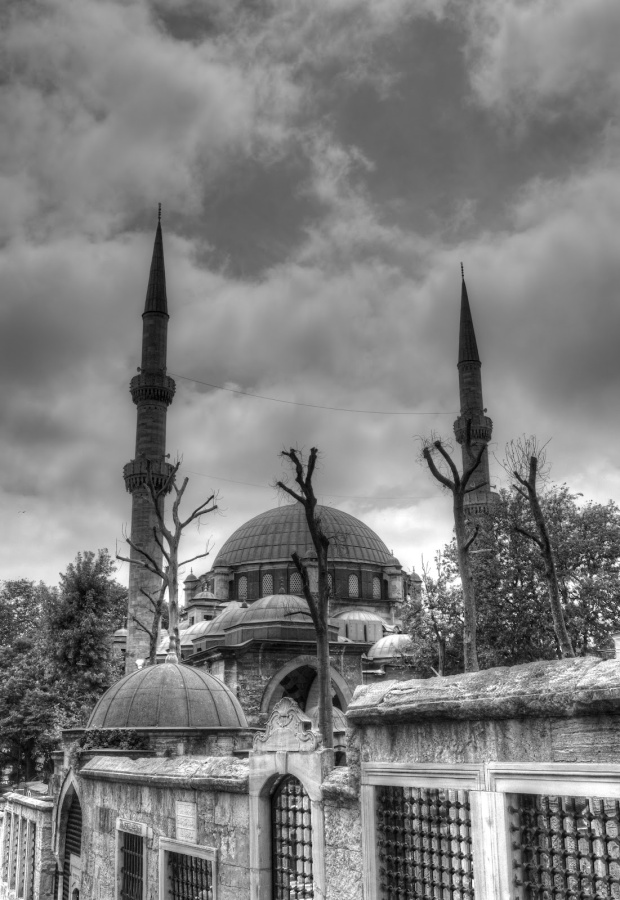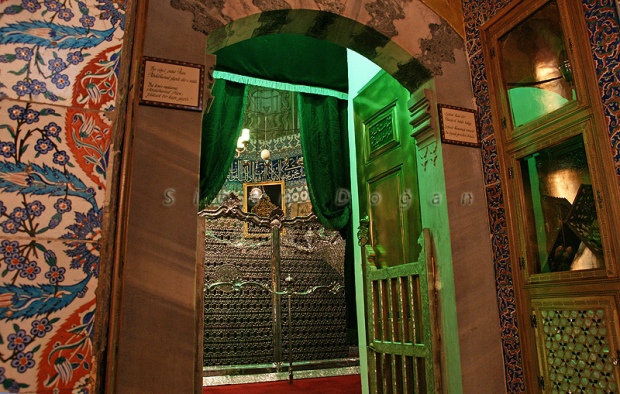MAUSOLEUM OF ABU AYYUB AL-ANSARI (D. 54H)
👉 ‘Roza e Rasul ﷺ’ khud ek sabut he Auliya Allah ke Mazaar Shariif banane ka
👉 Roza e Rasul ﷺ is itself a Proof of Constructing Tombs of Auliya Allah
✅ YouTube Link of above Video: https://youtu.be/GR-Xpy_zVd4
MAUSOLEUM OF ABU AYYUB AL-ANSARI (D. 54H)

Eyup Sultan mosque built over the mausoleum of Abu Ayyub al-Ansari(r) by Sultan Mehmed II when Muslims first conquered Constantinople in 1453 AD . Prophet Muhammed (peace be upon him) said: “Verily you shall conquer Constantinople. What a wonderful leader will he be, and what a wonderful army will that army be!”
Abu Ayyub al-Ansari (may Allah have mercy on him), a prominent companion of the Prophet (peace and blessings be upon him), was present during the first battles for Constantinople. He had fallen severely ill during those battles and personally requested his companions that after his passing away they are to penetrate deep into enemy territory and bury him near the walls of the fort of Constantinople. His companions than buried him as requested.
Ibn Asakir (d. 571H) in his book “Tariqh Dimashq” narrates the events surrounding the death of Abu Ayyub al-Ansari where he also than mentions the details of the mausoleum that was built over the grave, quoting from the salaf, that he:
أبا أيوب الأنصاري وهو خالد بن زيد غزا بلاد الروم فمات بالقسطنطينية فقبر مع سور المدينة وبني عليه
………died in Constantinople and his grave is at the walls of the city and built upon.
………died in Constantinople and his grave is at the walls of the city and built upon.
and further quotes that :
قال فبنوا عليه قبة بيضاء وأسرجوا عليه قنديلا قال أبو سعيد وأنا دخلت عليه القبة في سنة مائة ورأيت قنديلها فعرفنا أنه لم يزل يسرج حتى نزلنا بهم
built upon (his grave) is a white dome and a lamp is lit over it (i.e., the grave). Abu Said said he visited the dome in year 100H and saw the lamp still hanging …
built upon (his grave) is a white dome and a lamp is lit over it (i.e., the grave). Abu Said said he visited the dome in year 100H and saw the lamp still hanging …
and in another narration (which is also recorded in al Khatib al Baghdadi’s “Tariqh Baghdad“) quotes:
قال الوليد هذا قبر أبي أيوب الأنصاري صاحب النبي (صلى الله عليه وسلم) فأتيت تلك البنية فرأيت قبره في تلك البنية وعليه قنديل معلق بسلسلة
Al Walid saying that he came to the structure and saw the grave with a lamp hanging in chains over it.

His grave was a infact a famous place of visitation and tawassul. Imam al-Hakim in his “Mustadarak”, Ibn al-Jawzi in “Sifat al Safwa”, Ibn Asakir in “Tariqh Dimashq” and others quote al-Waqidi (d. 204H) saying:
محمد بن عمر قال وتوفي أبو أيوب عام غزا يزيد بن معاوية القسطنطينية في خلافة أبيه معاوية بن أبي سفيان سنة اثنتين وخمسين وصلى عليه يزيد بن معاوية وقبره بأصل حصن القسطنطينية بأرض الروم فلقد بلغني أن الروم يتعاهدون قبره ويرمونه ويستسقون به إذا قحطوا
“………It has reached us that the Eastern Romans visit his grave and seek rain through his intercession when they suffer from droughts.”
“………It has reached us that the Eastern Romans visit his grave and seek rain through his intercession when they suffer from droughts.”
Ibn ‘Abd-ul-Barr (d. 463H) in “al-Istiab” narrates a similar saying from Imam Malik:
الَ ابْن القاسم، عَنْ مالك: بلغني عَنْ قبر أبي أيوب أن الروم يستصحون به ويستسقون
http://shamela.ws/browse.php/book-12288/page-1590
http://shamela.ws/browse.php/book-12288/page-1590
And recorded by Ibn ‘Abd-ul-Barr in the same book “al-Istiab” is another report [also narrated in Ibn al-Jawzi’s “Sifat al Safwa”; Abu Nu’aym’s Hilya al-Awliya'; al-Dhahabi’s Mizan and Siyar]:
قَالَ مجاهد: كانوا إذا أمحلوا كشفوا عَنْ قبره فمطروا
Mujahid said: “People would uncover the space above his grave and it would rain.”
Mujahid said: “People would uncover the space above his grave and it would rain.”
From all of this we see the following:
- The mausoleum of the companion Abu Ayyub al-Ansari (RA) was constructed at the time of the salaf.
- The mausoleum was not labelled as idolatry or “shirki temple” or “shiasm” and destroyed as the 18th century Wahhabi religion preaches.
- Tawassul was sought from the time of salaf and proves tawassul by the grave was an established practice in Islam, and this practice continues to be followed by Muslims till today.
- Non-Muslims also sought tawassul and none of the Muslims objected to that nor labelled that as perennialism and mixing of religions, as the Wahhabiyya would like to portray. The Muslims instead mentioned it in praise of Abu Ayyub al-Ansari (may Allah have mercy on him).